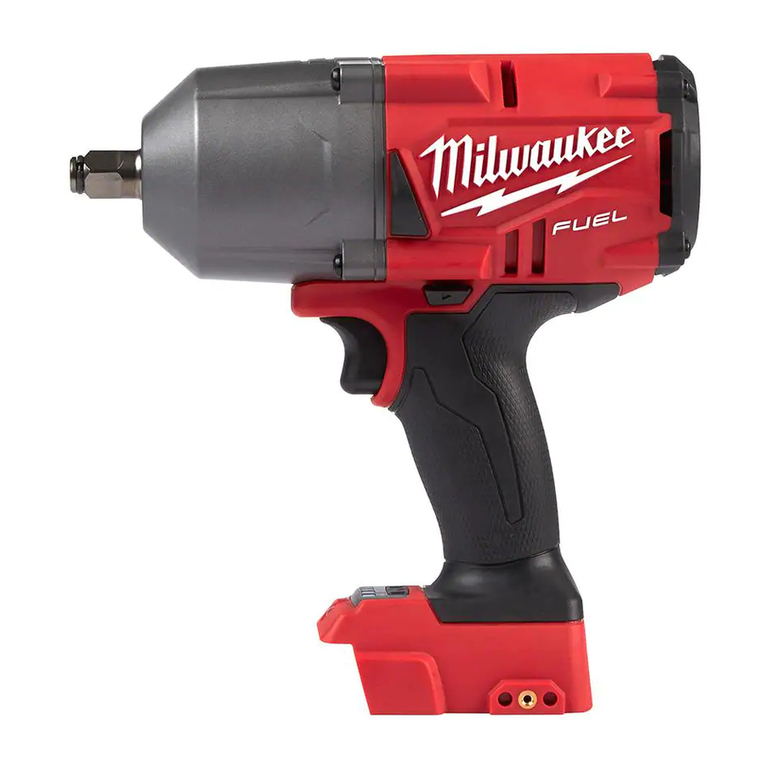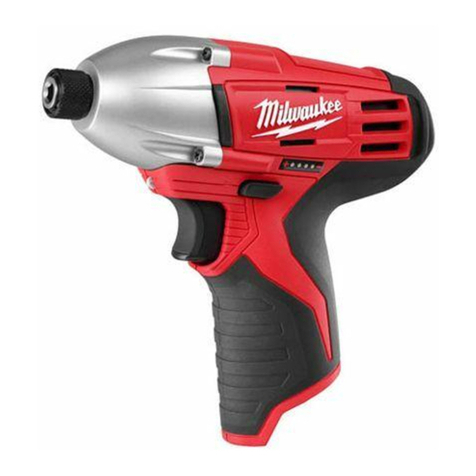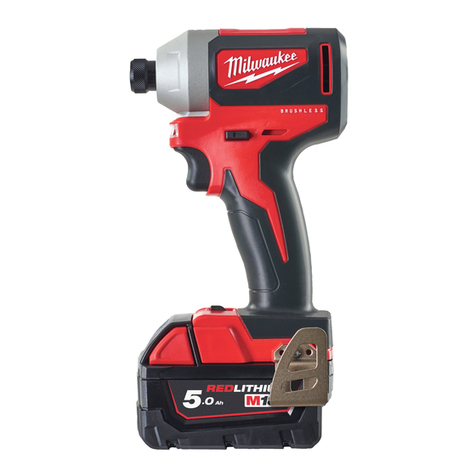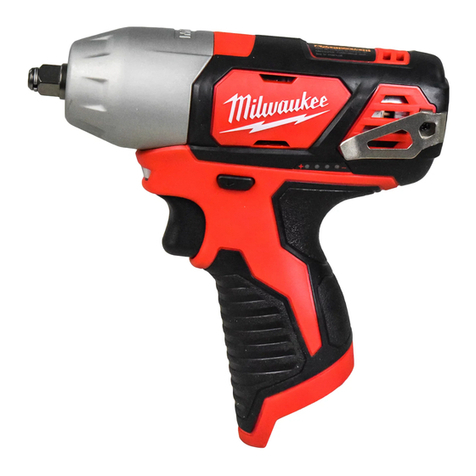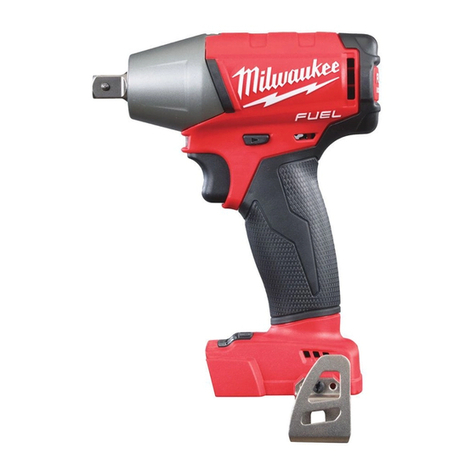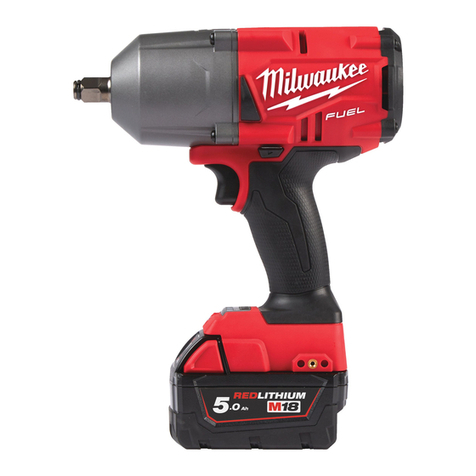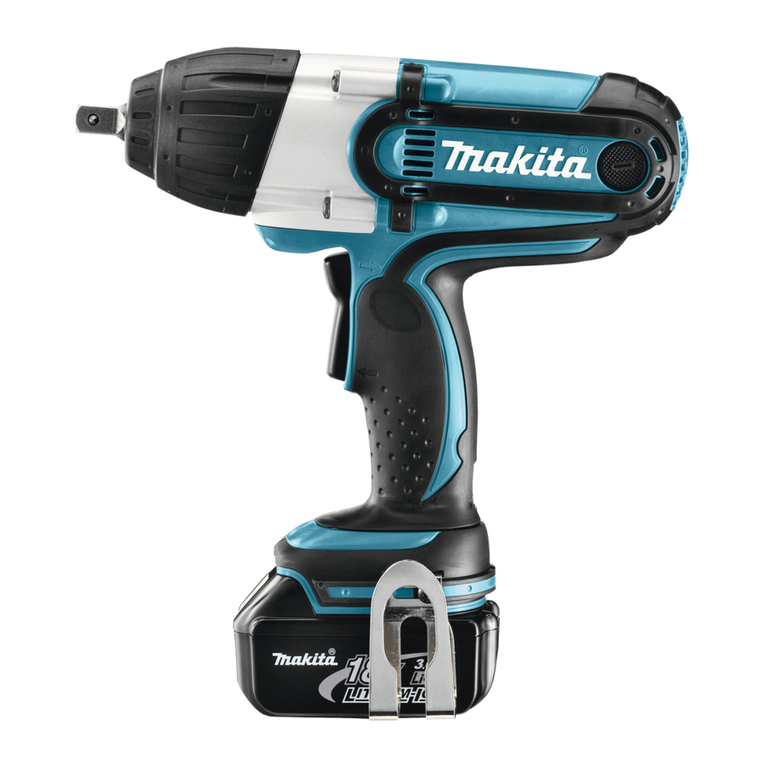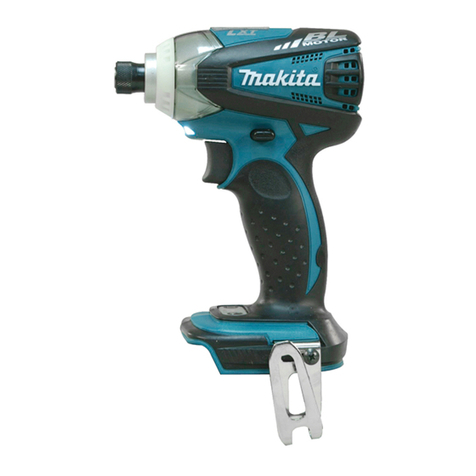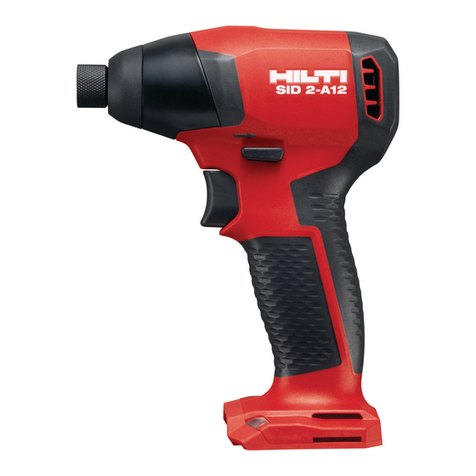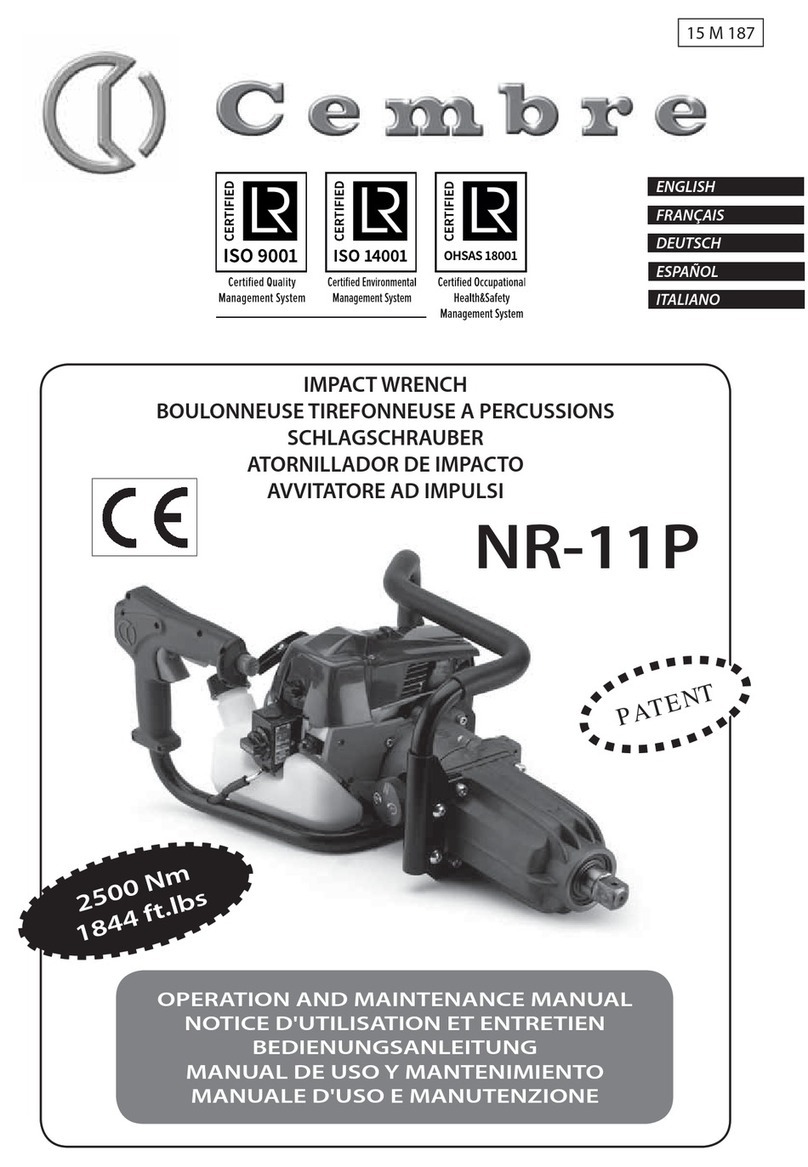
23
PERSONAL SAFETY
GENERAL POWER TOOL SAFETY WARNINGS
WORK AREA SAFETY
ELECTRICAL SAFETY
•Keep work area clean and well lit. Cluttered or
dark areas invite accidents.
•Do not operate power tools in explosive at-
mospheres, such as in the presence of flam-
mable liquids, gases or dust. Powertoolscreate
sparks which may ignite the dust or fumes.
•Keep children and bystanders away while
operating a power tool. Distractions can cause
you to lose control.
•Power tool plugs must match the outlet. Never
modify the plug in any way. Do not use any
adapter plugs with earthed (grounded) power
tools. Unmodifiedplugs and matchingoutlets will
reduce risk of electric shock.
•Avoid body contact with earthed or grounded
surfaces such as pipes, radiators, ranges and
refrigerators.Thereisanincreasedriskofelectric
shock if your body is earthed or grounded.
•Do not expose power tools to rain or wetcondi-
tions. Water entering a power tool will increase
the risk of electric shock.
•Do not abuse the cord. Never use the cord for
carrying, pulling or unplugging the power tool.
Keep cord away from heat, oil, sharp edges
or moving parts. Damaged or entangled cords
increase the risk of electric shock.
•When operating a power tool outdoors, use an
extension cord suitable for outdoor use. Use
of a cord suitable for outdoor use reduces the risk
of electric shock.
•If operating a power tool in a damp location
is unavoidable, use a residual current device
(RCD) protected supply. Use of an RCD reduces
the risk of electric shock.
attached to a rotating part of the power tool may
result in personal injury.
•Do not overreach. Keep proper footing and
balance at all times. This enables better control
of the power tool in unexpected situations.
•Dress properly. Do not wear loose clothing or
jewellery. Keep your hair, clothing and gloves
away from moving parts. Loose clothes, jewel-
lery or long hair can be caught in moving parts.
•If devices are provided for the connection of
dust extraction and collection facilities, ensure
these are connected and properly used. Use of
dust collection can reduce dust-related hazards.
WARNING READ ALL SAFETY WARNINGS AND ALL INSTRUCTIONS.
Failure to follow the warnings and instructions may result in electric shock, fire and/or
serious injury. Save all warnings and instructions for future reference.
The term "power tool" in the warnings refers to your mains-operated (corded) power tool or
battery-operated (cordless) power tool.
POWER TOOL USE AND CARE
•Do not force the power tool. Use the correct
power tool for your application. The correct
power tool will do the job better and safer at the
rate for which it was designed.
•Do not use thepowertooliftheswitchdoesnot
turn it on and off. Any power tool that cannot be
controlled with the switch is dangerous and must
be repaired.
•Disconnect the plug from the power source
and/or the battery pack from the power tool
before making any adjustments, changing
accessories, or storing power tools. Such
preventive safety measures reduce the risk of
starting the power tool accidentally.
•Store idle power tools out of the reach of chil-
dren and do not allow persons unfamiliar with
the power tool or these instructions to operate
the power tool. Powertools are dangerous inthe
hands of untrained users.
•Maintain power tools. Check for misalignment
or binding of moving parts, breakage of parts
and any other condition that may affect the
power tool’s operation. If damaged, have the
power tool repaired before use. Manyaccidents
are caused by poorly maintained power tools.
•Keep cutting tools sharp and clean. Properly
maintained cutting tools with sharp cutting edges
are less likely to bind and are easier to control.
•Use the power tool, accessories and tool bits
etc., in accordance with these instructions,
takingintoaccounttheworkingconditionsand
the work to be performed. Use of the power tool
for operations different from those intended could
result in a hazardous situation.
•Stay alert, watch what you are doing and use
common sensewhen operatinga powertool. Do
not usea power toolwhile youare tired orunder
theinfluenceof drugs, alcohol or medication. A
moment of inattention while operating power tools
may result in serious personal injury.
•Use personal protective equipment. Always
wear eye protection. Protective equipment such
as dust mask, non-skid safety shoes, hard hat, or
hearingprotection used for appropriate conditions
will reduce personal injuries.
•Prevent unintentional starting. Ensure the
switch is in the off-position before connecting
to power source and/or battery pack, picking
up or carrying the tool. Carryingpowertoolswith
yourfingeron the switch or energisingpowertools
that have the switch on invites accidents.
•Remove any adjusting key or wrench before
turning the power tool on. Awrench or a key left
•Recharge only with the charger specified by
the manufacturer. A charger that is suitable for
one type of battery pack may create a risk of fire
when used with another battery pack.
•Use power tools only with specifically desig-
nated battery packs. Use of any other battery
packs may create a risk of injury and fire.
BATTERY TOOL USE AND CARE
SPECIFIC SAFETY RULES
•When battery pack is not in use, keep it away
from other metal objects, like paper clips,
coins, keys, nails, screws or other small metal
objects, that can make a connection from one
terminal to another. Shorting the battery termi-
nals together may cause burns or a fire.
•Under abusive conditions, liquid may be eject-
ed from the battery; avoid contact. If contact
accidentally occurs, flush with water. If liquid
contacts eyes, additionally seek medical help.
Liquidejectedfromthebatterymaycause irritation
or burns. SERVICE
•Have your power tool serviced by a qualified
repair person using only identical replacement
parts. Thiswill ensure that thesafety of the power
tool is maintained.
•Hold power tool byinsulatedgripping surfaces,
when performing an operation where the fas-
tener may contact hidden wiring. Fasteners
contacting a “live” wire may make exposed metal
parts of the power tool “live” and could give the
operator an electric shock.
•Wear ear protectors when impact drilling.
Exposure to noise can cause hearing loss.
•Use only sockets and other accessories spe-
cifically designed for use on impact wrenches
and drivers. Othersocketsandaccessoriesmight
shatter or break causing injury.
•Maintain labels and nameplates. These carry
important information. If unreadable or missing,
contact a MILWAUKEE service facility for a free
replacement.
•WARNING: Somedust createdbypowersanding,
sawing, grinding, drilling, and other construction
activities contains chemicals known to cause
cancer, birth defects or other reproductive harm.
Some examples of these chemicals are:
•lead from lead-based paint
•crystalline silica from bricksand cement and other
masonry products, and
•arsenic and chromium from chemically-treated
lumber.
Yourrisk from theseexposures varies, depending
on how often you do this type of work. To reduce
your exposure to these chemicals: work in a well
ventilated area, and work with approved safety
equipment,suchasthosedustmasksthatare spe-
cially designed to filter out microscopic particles.
Cat. No. Volts DC RPM IPM
2656-20
2657-20
2658-20
2659-20
18
18
18
18
0-2750
High 0-2750
Low 0-2000
0-2450
0-2450
0-3450
High 0-3450
Low 0-2450
0-3350
0-3350
FUNCTIONAL DESCRIPTION
SPECIFICATIONS
1.1/4" Hex drive chuck
(2656-20, 2657-20))
2.LED
3.Control switch
4.Trigger
5.Speed control (2657-20)
6.Belt clip
7.3/8" Square drive anvil (2658-20)
8.1/2" Square drive anvil with pin detent (2659-20)
1
2
45
3
6
7
8
Cat. No. 2657-20
Cat. No.
2658-20
Cat. No.
2659-20
SYMBOLOGY
Volts
Direct Current
Impacts per Minute Under
Load (IPM)
No Load Revolutions per
Minute (RPM)
Underwriters Laboratories, Inc.
United States and Canada

